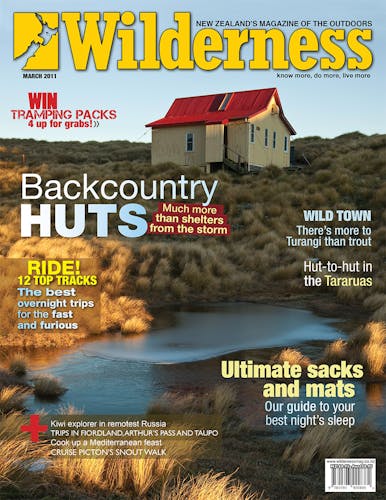Letter of the month
Scary memories of Dore Pass
One sentence near the top of page 59 of the December 2010 issue really captured my attention. In particular, two words: ‘Dore Pass’.
The day 57 years ago that I tangled with that track is forever etched in my memory. During February 1954, I did a solo 10 day tramp which included the Routeburn (Kinloch was the beginning of the track) Dore Pass, Milford and Greenstone tracks. By today’s standards the huts ranged from primitive to basic, but were still worth their weight in gold. The tracks were sometimes so narrow that the odd leech would accept a ride and feed.
Over the years I have followed the development of these and other tracks, except the Dore Pass, about which I have heard or read practically nothing.
Many years ago I remember words like ‘Hard’, ‘Testing’, ‘For guided parties only’ and even ‘Closed’ associated with the track but for about a decade, nothing. I assumed the track over Dore Pass was history. Thank you Nick Groves for putting me straight and reigniting the memory of that crossing.
I would welcome news of its present status and, even better, a recent map and report. The hairiest 50 yards of my tramping life were on that track. Just above the bushline a still active, hanging, slip had to be crossed. There was no alternative and I will never forget it!
– Alan Anson, Tairua
Possum numbers exaggerated
I read with some interest Stephen Conn’s letter about traps and possums (January, 2011) and his reference to 70 million possums.
That figure is a big fib by the Department of Conservation, a big figure dreamed up to justify their poison policies. It was criticised by Landcare Research in a DOC workshop as ‘a back of a cigarette pack’ calculation.
After years of erecting the 70 million munching possums, the figure has been halved to 30 or 40 million, I believe.
There are probably not even 30 million possums. As a former possum trapper and pest destruction office I can tell you: a) possums are spread very unevenly. Beech forest, for example, holds low numbers; b) maximum numbers are along lower bush margins. Forest holds much lower numbers.
As far as my eye is concerned, the possum problem is hyped up. The canopy is in fine condition. As for birds, possums are herbivores. The biggest threat is the wild cat.
– L Collins, West Coast
Credit where credit due
I was really pleased to see your coverage of Nga Haerenga: the NZ Cycle Trail Network (January 2011, p40). As your readers probably know, this is a joint project of the National Government and the Green Party (they provide the money, we provide the cycling expertise!)
The vision is for a network of purpose-built bike paths, rail trails, other off-road options like old forestry roads or tram tracks and the best backcountry roads for biking. We want riders of different interests and skill levels to all be able to meet their needs, whether these are cycle touring the length of the country, having a backcountry adventure, recreation with the family, commuting to work or school and everything in between.
As many readers will know, these kinds of network are common overseas and consistently show great economic benefit as well as all their other pluses.
Great news, too, with the Heaphy being reopened for dual use for part of the year. As one of those who has worked away on this for quite a long time now, I’d like to say a special thanks to the tramping community for the great support over the years. It’s been much appreciated. Now I just need to find enough time to ride it!
– Kevin Hague MP, Green Party
Hanmer Springs Ski Area
It was great to see the St James featuring in the recent publication, in particular our ski field get a mention (February 2011, p49).
A lot folk have yet to explore this great place and the 3D map is a great way to help people understand the area.
However, I would like to highlight a correction. The Amuri Ski Field was re-branded several years ago to form Hanmer Springs Ski Area. Although still run by the Amuri Ski Club (for which I sit on the committee) the old Amuri Ski field was put to bed.
Surprisingly, there are still people out there that think the Hanmer Springs Ski Area and Amuri Ski Field are two separate fields – they are not. We desperately try to avoid such confusion and communicate Hanmer Springs Ski Area as the ski area.
I would encourage people to visit Hanmer Springs Ski Area – it is one of New Zealand’s most iconic backcountry and family oriented ski fields.
– Dayle Sutherland, email






